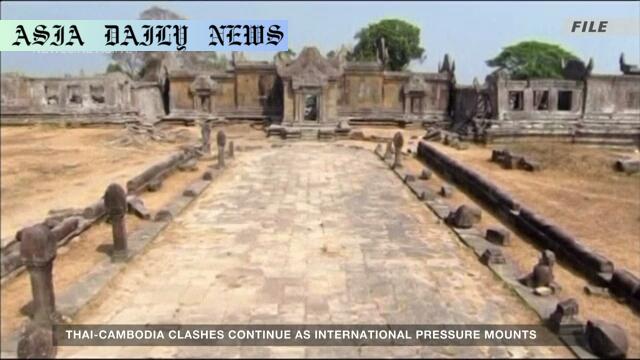Preah Vihear Temple: Cambodia accuses Thailand of attacking and damaging the ancient World Heritage site using shells and bombs.
- Preah Vihear Temple was shelled and damaged during Thailand and Cambodia border clashes.
- Thailand reports 14 deaths, including 1 soldier, with 100k evacuations.
- Malaysia appeals for a ceasefire with ASEAN leaders’ involvement.

Escalating Tensions at Preah Vihear Temple
Border tensions between Cambodia and Thailand have resulted in tragic consequences, with Cambodia accusing Thai forces of attacking the Preah Vihear Temple complex, a UNESCO-designated World Heritage site. According to reports from the Cambodian government, the ancient temple—renowned for its historical and cultural significance—was struck with shells and bombs, leading to widespread condemnation. The Cambodian government labeled the attack not only a crime against their nation’s heritage but also a serious offense against a global treasure that belongs to humanity. As combat unfolded in disputed regions along the border on Thursday, violence extended into Friday, sparking international concerns about the conflict’s repercussions.
The Preah Vihear Temple has been a point of historical contention between Cambodia and Thailand, sitting at the heart of a long-standing border dispute. While it has been under Cambodian sovereignty following a 1962 ruling by the International Court of Justice, tensions have flared repeatedly due to nationalist sentiments in both countries. The recent attack and subsequent clashes exacerbate the already delicate situation.
The Human Toll: Lives Lost, Families Displaced
On the Thai side, authorities have reported 14 fatalities, including one soldier, with over 40 wounded as a consequence of the unrest. Civilians have borne the brunt of the clashes, with over 100,000 residents forced to evacuate their homes, fearing further destruction or escalation. This mass displacement has placed an immense strain on communities and aid organizations, grappling with the logistical challenges of providing shelter and critical resources.
While Thailand has disclosed casualty figures and evacuation numbers, the Cambodian government has remained silent on casualties within their borders. This lack of communication has drawn speculation, with critics raising questions about Cambodia’s crisis management and transparency. Meanwhile, international organizations and human rights advocates are calling for thorough investigations into violations resulting from the violence.
Calls for Restraint and International Mediation
As violence continues, Malaysian Prime Minister Anwar Ibrahim has stepped forward in efforts to mediate peace. Leveraging Malaysia’s role as chair of the Association of Southeast Asian Nations (ASEAN), he has actively communicated with leaders on both sides, urging an immediate ceasefire. The ASEAN platform provides an opportunity for regional dialogue to cool escalating tempers and address underlying factors driving the conflict. By fostering communication between Cambodian and Thai authorities, ASEAN aims to prevent further harm to civilians and cultural heritage.
Though the aspirations for peaceful intervention are clear, the road to resolution remains uncertain. Historical grievances, nationalist fervor, and territorial complexities entwined with this dispute require tactful diplomacy. The involvement of international bodies such as UNESCO could emphasize the need to protect shared global heritage from the ravages of conflict. The Preah Vihear Temple—recognized for its splendor and historical significance—serves as a unifying symbol of Southeast Asia’s cultural wealth. Its preservation is paramount, requiring collective action.
The Need for Long-Term Solutions
Long-term peace will demand the establishment of transparent, equitable resolutions to the broader territorial dispute. Dialogues surrounding shared custodianship or multinational agreements protecting the temple complex may pave the way for less conflict-prone relations. Both Thailand and Cambodia must also consider how nationalist rhetoric inflames tensions, marginalizing the clear mutual benefits of cooperative relations.
The human suffering precipitated by the conflict reiterates the need for regional integration and confidence-building measures. In the wake of this tragedy, both nations and ASEAN must spur greater commitments to non-violent conflict resolution mechanisms. By prioritizing dialogue, humanitarian considerations, and cultural preservation, stakeholders can foster stability and respect for shared histories. Addressing the inherent complexities in bilateral relations with patience and accountability may prevent future hostilities.



Commentary
The Significance of the Preah Vihear Temple
The Preah Vihear Temple stands as a beacon of cultural and historical heritage, representing the architectural and religious ingenuity of the Khmer Empire. Its iconic status as a UNESCO-recognized World Heritage site signifies not only its relevance to Cambodian identity but also its importance to humanity as a historic monument. As combat encroaches upon this cherished landmark, the damage inflicted resonates far beyond national boundaries and highlights humanity’s collective responsibility to preserve history’s treasures.
Human Costs of Sovereignty Disputes
Beyond geopolitical implications, the clashes emphasize grave human costs. Displacement of over 100,000 residents and the tragic loss of 14 lives underscore the devastating impact of military escalations. These numbers do not merely represent statistics, but the fractured lives of families forced to flee, leaving homes and livelihoods behind. Children deprived of education, communities torn apart, and the psychological trauma of war highlight the breadth of suffering. Governments on both sides must confront their failures in prioritizing people’s safety and security amidst nationalistic ventures.
Fostering Peaceful Coexistence
Restoring peace will entail difficult negotiations, requiring compromises and transparency. Both Cambodia and Thailand must engage in meaningful dialogues that acknowledge the region’s historical complexities while prioritizing the immediate well-being of citizens and shared cultural legacies. This incident presents a pivotal moment for ASEAN to affirm its role as a mediator in resolving disputes within the region, advocating for stability and collaboration. By safeguarding both human and cultural capital, Southeast Asia has an opportunity to emerge as a stronger and more unified region.